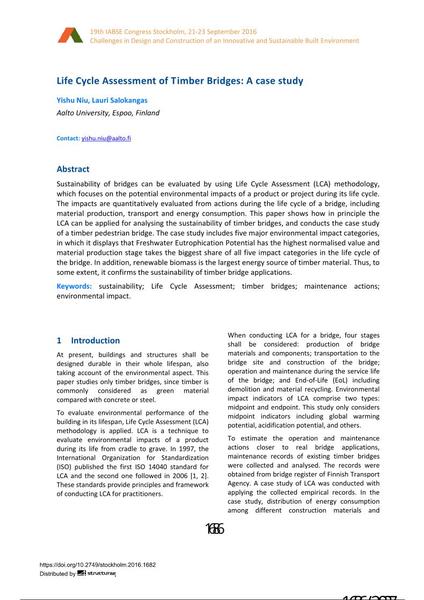Life Cycle Assessment of Timber Bridges: A case study

|
|
|||||||||||
Bibliografische Angaben
| Autor(en): |
yishu Niu
(Aalto University, Espoo, Finland)
Lauri Salokangas (Aalto University, Espoo, Finland) |
||||
|---|---|---|---|---|---|
| Medium: | Tagungsbeitrag | ||||
| Sprache(n): | Englisch | ||||
| Tagung: | IABSE Congress: Challenges in Design and Construction of an Innovative and Sustainable Built Environment, Stockholm, Sweden, 21-23 September 2016 | ||||
| Veröffentlicht in: | IABSE Congress Stockholm, 2016 | ||||
|
|||||
| Seite(n): | 1686-1692 | ||||
| Anzahl der Seiten (im PDF): | 7 | ||||
| Jahr: | 2016 | ||||
| DOI: | 10.2749/stockholm.2016.1682 | ||||
| Abstrakt: |
Sustainability of bridges can be evaluated by using Life Cycle Assessment (LCA) methodology, which focuses on the potential environmental impacts of a product or project during its life cycle. The impacts are quantitatively evaluated from actions during the life cycle of a bridge, including material production, transport and energy consumption. This paper shows how in principle the LCA can be applied for analysing the sustainability of timber bridges, and conducts the case study of a timber pedestrian bridge. The case study includes five major environmental impact categories, in which it displays that Freshwater Eutrophication Potential has the highest normalised value and material production stage takes the biggest share of all five impact categories in the life cycle of the bridge. In addition, renewable biomass is the largest energy source of timber material. Thus, to some extent, it confirms the sustainability of timber bridge applications. |
||||
| Stichwörter: |
Umweltbelastung Nachhaltigkeit Lebenszyklusanalyse
|
||||

